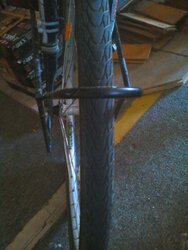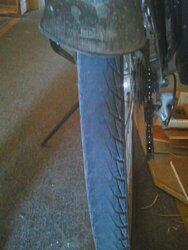jhawk
Veteran
- Location
- New Brunswick, Canada
Hi all, a bit of a two-parter here for your brains to pick.
I won't call it 'a problem' with my touring tyres, I have Schwalbe Marathon Pluses and as much as I love them, I can't help but feel as though I'm paying way too much attention to them when I'm cycling.
Punctures are b*stards as everyone knows, and I've never had to fix a puncture on the road before, only once I brought my deflated mountain bike tyres home and fixed the puncture here.
Is there any way to tell if a tyre has got a puncture before it goes completely flat? What are some things to look for if this is the case?
I do my best to avoid glass, nails, bits of wire, etc. All these things that in the past have been the enemy with the old cheap MTB tyres.
I should mention that the Schwalbe Marathon Pluses have been across Canada - a distance of 5,000 miles, before I received them and I have put... Oh, I don't know, probably just over 200 miles on them so far. But that will increase this summer.
Here are the front and rear tyres for your observation:


I suppose the question is - am I just being paranoid, or should I look at getting a set of new tyres?
Cheers,
Jack.
I won't call it 'a problem' with my touring tyres, I have Schwalbe Marathon Pluses and as much as I love them, I can't help but feel as though I'm paying way too much attention to them when I'm cycling.
Punctures are b*stards as everyone knows, and I've never had to fix a puncture on the road before, only once I brought my deflated mountain bike tyres home and fixed the puncture here.
Is there any way to tell if a tyre has got a puncture before it goes completely flat? What are some things to look for if this is the case?
I do my best to avoid glass, nails, bits of wire, etc. All these things that in the past have been the enemy with the old cheap MTB tyres.
I should mention that the Schwalbe Marathon Pluses have been across Canada - a distance of 5,000 miles, before I received them and I have put... Oh, I don't know, probably just over 200 miles on them so far. But that will increase this summer.
Here are the front and rear tyres for your observation:


I suppose the question is - am I just being paranoid, or should I look at getting a set of new tyres?
Cheers,
Jack.






